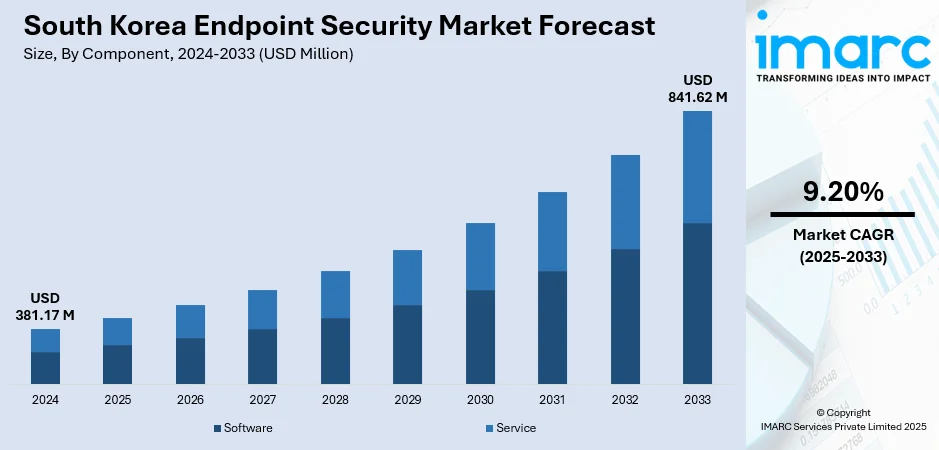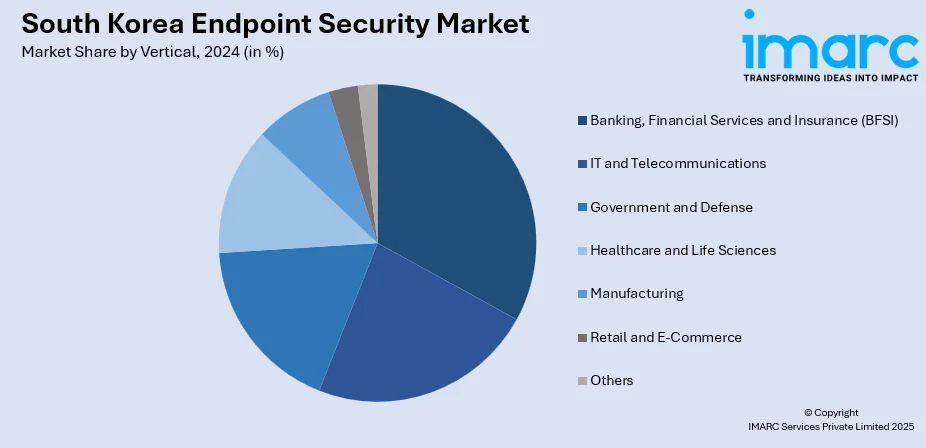
South Korea Endpoint Security Market Size, Share, Trends and Forecast by Component, Deployment Mode, Organization Size, Vertical, and Region, 2025-2033
South Korea Endpoint Security Market Overview:
The South Korea endpoint security market size reached USD 381.17 Million in 2024. Looking forward, IMARC Group expects the market to reach USD 841.62 Million by 2033, exhibiting a growth rate (CAGR) of 9.20% during 2025-2033. The market is driven by rising cybersecurity threats, increasing adoption of BYOD (Bring Your Own Device), and stringent government regulations on data privacy. The need for robust security measures to protect critical infrastructures and corporate data also fuels the market. As cyber threats evolve, businesses increasingly invest in advanced endpoint security solutions, contributing to the South Korea endpoint security market share.
|
Report Attribute
|
Key Statistics
|
|---|---|
|
Base Year
|
2024
|
|
Forecast Years
|
2025-2033
|
|
Historical Years
|
2019-2024
|
| Market Size in 2024 | USD 381.17 Million |
| Market Forecast in 2033 | USD 841.62 Million |
| Market Growth Rate 2025-2033 | 9.20% |
South Korea Endpoint Security Market Trends:
Growing Cyber Threats and Targeted Attacks
The increasing sophistication of cyber threats such as ransomware and phishing attacks is a key factor driving the South Korea endpoint security market growth. For instance, in April 2025, Kaspersky uncovered a sophisticated cyberattack by the Lazarus group targeting South Korean supply chains. Using a watering hole attack, the group exploited vulnerabilities in third-party software, including a zero-day flaw in Innorix Agent. At least six South Korean organizations across IT, finance, and telecom sectors were affected. The malware involved, such as ThreatNeedle and LPEClient, was deployed through an attack chain. Kaspersky collaborated with the Korea Internet & Security Agency (KrCERT) to address the vulnerabilities, highlighting the security risks from third-party software. Organizations are facing more advanced and persistent security risks targeting their endpoints, including mobile devices, laptops, and IoT devices. These attacks can lead to significant financial losses, data breaches, and reputational damage, pushing companies to adopt advanced endpoint security solutions. As a result, demand for solutions that offer proactive threat detection, real-time monitoring, and rapid response capabilities has surged. Additionally, the increasing use of AI-driven tools for threat intelligence is enhancing the ability of endpoint security solutions to detect and mitigate these evolving threats effectively.

To get more information on this market, Request Sample
Stringent Regulatory and Compliance Requirements
The South Korean government has implemented stringent data protection regulations to safeguard personal and corporate data, fueling the demand for robust endpoint security solutions. These regulations, such as the Personal Information Protection Act (PIPA), require businesses to comply with strict data security standards. As a result, organizations are increasingly turning to advanced endpoint security solutions to ensure compliance and avoid heavy penalties. Endpoint security products that offer data encryption, secure access control, and compliance reporting features are becoming essential. Moreover, with the growing focus on protecting consumer data and ensuring organizational resilience against cyber-attacks, businesses are investing in solutions that align with regulatory requirements, further driving the South Korea endpoint security market share. For instance, in July 2025, the South Korean government imposed a fine and regulatory requirements on SK Telecom following a data breach that exposed 27 million records. After a task force investigation, 28 servers were found infected with 33 strains of malware, including BPFDoor. SK Telecom faces penalties and must take corrective actions such as quarterly security assessments and improving password management. This breach highlights the vulnerability of telecom companies and the importance of timely breach notifications in South Korea’s growing cybersecurity landscape.
South Korea Endpoint Security Market Segmentation:
IMARC Group provides an analysis of the key trends in each segment of the market, along with forecasts at the country and regional levels for 2025-2033. Our report has categorized the market based on component, deployment mode, organization size, and vertical.
Component Insights:
- Software
- Services
The report has provided a detailed breakup and analysis of the market based on the component. This includes software and services.
Deployment Mode Insights:
- On-premises
- Cloud-based
A detailed breakup and analysis of the market based on the deployment mode have also been provided in the report. This includes on-premises and cloud-based.
Organization Size Insights:
- Large Enterprises
- Small and Medium-sized Enterprises
The report has provided a detailed breakup and analysis of the market based on the organization size. This includes large enterprises and small and medium-sized enterprises.
Vertical Insights:

- Banking, Financial Services and Insurance (BFSI)
- IT and Telecommunications
- Government and Defense
- Healthcare and Life Sciences
- Manufacturing
- Retail and E-Commerce
- Others
A detailed breakup and analysis of the market based on the vertical have also been provided in the report. This includes banking, financial services and insurance (BFSI), IT and telecommunications, government and defense, healthcare and life sciences, manufacturing, retail and e-commerce, and others.
Regional Insights:
- Seoul Capital Area
- Yeongnam (Southeastern Region)
- Honam (Southwestern Region)
- Hoseo (Central Region)
- Others
The report has also provided a comprehensive analysis of all the major regional markets, which include Seoul Capital Area, Yeongnam (Southeastern Region), Honam (Southwestern Region), Hoseo (Central Region), and others.
Competitive Landscape:
The market research report has also provided a comprehensive analysis of the competitive landscape. Competitive analysis such as market structure, key player positioning, top winning strategies, competitive dashboard, and company evaluation quadrant has been covered in the report. Also, detailed profiles of all major companies have been provided.
South Korea Endpoint Security Market News:
- In April 2025, Forcepoint launched its AI-powered Data Security Cloud, consolidating visibility and control across data security processes. The platform integrates Data Security Posture Management (DSPM), Data Detection and Response (DDR), Enterprise DLP, and more. By uniting these features, it helps businesses manage and protect sensitive data while reducing security policies by up to 90%. This innovation, enhanced by Forcepoint’s acquisition of Getvisibility, promises improved risk detection, dynamic controls, and simplified management for hybrid environments.
- In March 2024, ThreatResponder, an AI-based integrated endpoint security solution, has been launched in South Korea by NetSecurity. This next-gen platform consolidates various endpoint security functions, including threat detection, response, analysis, and forensics, into a single solution. It uses AI and machine learning to detect vulnerabilities like zero-day exploits and malware and provides automated malware analysis and remote incident response. The solution aims to enhance operational efficiency and forensic capabilities across industries such as finance, manufacturing, and logistics.
South Korea Endpoint Security Market Report Coverage:
| Report Features | Details |
|---|---|
| Base Year of the Analysis | 2024 |
| Historical Period | 2019-2024 |
| Forecast Period | 2025-2033 |
| Units | Million USD |
| Scope of the Report |
Exploration of Historical Trends and Market Outlook, Industry Catalysts and Challenges, Segment-Wise Historical and Future Market Assessment:
|
| Components Covered | Software, Services |
| Deployment Modes Covered | On-premises, Cloud-based |
| Organization Sizes Covered | Large Enterprises, Small and Medium-sized Enterprises |
| Verticals Covered | Banking, Financial Services and Insurance (BFSI), IT and Telecommunications, Government and Defense, Healthcare and Life Sciences, Manufacturing, Retail and E-Commerce, Others |
| Regions Covered | Seoul Capital Area, Yeongnam (Southeastern Region), Honam (Southwestern Region), Hoseo (Central Region), Others |
| Customization Scope | 10% Free Customization |
| Post-Sale Analyst Support | 10-12 Weeks |
| Delivery Format | PDF and Excel through Email (We can also provide the editable version of the report in PPT/Word format on special request) |
Key Questions Answered in This Report:
- How has the South Korea endpoint security market performed so far and how will it perform in the coming years?
- What is the breakup of the South Korea endpoint security market on the basis of component?
- What is the breakup of the South Korea endpoint security market on the basis of deployment mode?
- What is the breakup of the South Korea endpoint security market on the basis of organization size?
- What is the breakup of the South Korea endpoint security market on the basis of vertical?
- What is the breakup of the South Korea endpoint security market on the basis of region?
- What are the various stages in the value chain of the South Korea endpoint security market?
- What are the key driving factors and challenges in the South Korea endpoint security market?
- What is the structure of the South Korea endpoint security market and who are the key players?
- What is the degree of competition in the South Korea endpoint security market?
Key Benefits for Stakeholders:
- IMARC’s industry report offers a comprehensive quantitative analysis of various market segments, historical and current market trends, market forecasts, and dynamics of the South Korea endpoint security market from 2019-2033.
- The research report provides the latest information on the market drivers, challenges, and opportunities in the South Korea endpoint security market.
- Porter's five forces analysis assist stakeholders in assessing the impact of new entrants, competitive rivalry, supplier power, buyer power, and the threat of substitution. It helps stakeholders to analyze the level of competition within the South Korea endpoint security industry and its attractiveness.
- Competitive landscape allows stakeholders to understand their competitive environment and provides an insight into the current positions of key players in the market.
Need more help?
- Speak to our experienced analysts for insights on the current market scenarios.
- Include additional segments and countries to customize the report as per your requirement.
- Gain an unparalleled competitive advantage in your domain by understanding how to utilize the report and positively impacting your operations and revenue.
- For further assistance, please connect with our analysts.
 Request Customization
Request Customization
 Speak to an Analyst
Speak to an Analyst
 Request Brochure
Request Brochure
 Inquire Before Buying
Inquire Before Buying




.webp)




.webp)












